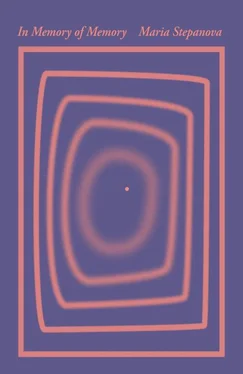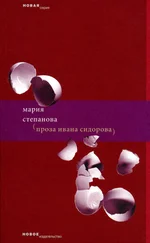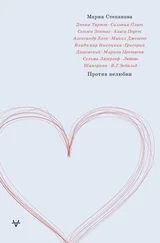Or perhaps, even more importantly, the face on their correspondence. The greatest part of any legacy was textual: diaries, letters, memoirs, and the balance between the textual and the visual shifted only from the mid-nineteenth century onward, as the pile of photographs accumulated. These presented themselves to the memory not as “me, as I am,” but “me on Saturday in my black riding habit.” The number of photographs a family owned depended solely on their financial means and their social position, but even my grandmother’s nanny, Mikhailovna, had three photos in her keeping.
The old lady of painting (for brevity’s sake that’s what I’ve named the ability to depict the living, by one’s own hand, in any medium) is haunted by the impossibility of resemblance, and yet she becomes increasingly obsessed by the task of producing an exhaustive image, but a single image; an exact image, but an image that does not resemble the sitter; to present to the sitter in his concentrated form, not him-now, but him-forever, a bouillon cube of his vital parts. This is what lies behind the stories about Gertrude Stein becoming with the years more and more like her portrait by Picasso, or the story about Oskar Kokoschka’s subject, who (it is said) subsequently went mad and came to look exactly like his image.
We are the permanent subject of the old lady’s interest, and we know all too well that in place of resemblance she sells us a horoscope: a template interpretation, and we can either agree with it — the mirror flatters me — or refuse it. Once the photographic image appears, Madame Bovary is free to say c’est moi for the first time, as she picks out the most attractive of the thirty-six negatives. Life offers her a new mirror and it reflects fervently, demanding nothing, insisting on nothing.
Painting and photography go their separate ways at this point. One rushes to its inevitable end, its dispersal, and the other toward its vast proliferation. When the inheritance is divided up, one gets the house and garden, the other gets a pig in a poke. Martha takes reality, Mary is left to talk in the language of abstraction and installations.
*
With the invention of digital photography, yesterday and today have coexisted with unprecedented intensity. It’s as if the waste chute in a building has been blocked off and all the trash just keeps piling up forever. There’s no need to save film, just press the shutter release, even the deleted pictures remain in the computer’s long memory. Oblivion, the copycat of nonexistence, has a new twin brother: the dead memory of the collector. We look through a family album with a sense of affection — it contains a little, perhaps just what remains. But what should we do with an album containing everything, without exception, the whole disproportionate volume of the past? Photography is directed at an endpoint, where the volume of life fixed in images is equal to the actual length of life. The printing press keeps turning, but there are no readers left.
I imagine the piles of images. Huge diggers shovel at them, scooping all the waste into their buckets: the underexposed pictures, the duplicates and triplicates, the tail of an out-of-frame dog, a picture of a café ceiling taken by mistake. We get a vague sense of the vast mass from social media, where thousands of mediocre pictures are posted, pinned like butterflies with “tags.” For these images the future is just one more cemetery, a huge archive of human bodies we know nothing about for the most part, except that they existed.
This immortality is terrifying, but even more terrifying is the fact that it is imposed on you. What photography now registers is nothing other than the body of death: the part of me that has no personal will or choice, which anyone can claim, which is fixed and preserved without effort. It is the part that dies, and not the part that remains.
In the past immortality was a matter of choice, though you could reject it and choose what everyone was offered as a matter of course: “to be laid in a narrow cell forever.” Now that forever narrow cell of “Gray’s Elegy” has been withdrawn and we have accepted the impossibility of simply disappearing. Whether you want it or not, you are facing the strange extension of your existence, your outward form preserved for all time. All that disappears is what made you yourself.
It is a luxury permitted to very few to vanish entirely, to disappear from the radar.
You step into another photograph, it is as inevitable as stepping out into sudden summer rain. Who will actually look at all these images and when will they do it? Our outward form is scratched from us by a thousand CCTV cameras at stations, streetcar stops, in shops and underpasses — like the fingerprints left everywhere by humanity before forensics were invented. It has no alphabet, only the new (old) multitudinous nature of leaves in a forest.
Since we began recording and archiving sound, the unreproducible has disappeared from life. How Mademoiselle George acted on the stage and how Angiolina Bosio sang was described to us, and demanded time and passion of the curious: you had to imagine, flesh it out, recreate something in your head. Now there is nothing between you and what has been. The longer we keep recording the more people will fall into the zone of the undead. Their physical form keeps on walking and talking, their earthly voice resounds whenever you want it to. They still have it within their power to charm, to arouse desire, or to disgust (the body and the name separate, like film credits). The culmination of this is pornography from the distant past, nameless dead bodies performing their mechanical duties long after their owners are ashes and dust.
Still, the physical body cannot be handed down in this way — it carries no caption with its name and description. It has no distinguishing features. It is divested of all memory retrospectively, of any trace of what has happened to it: its history, its biography, its death. This divestment makes it obscenely contemporary. The more naked it is, the nearer it is to us, and the further from human memory. We know only two things about these people: that they are dead and that they had no interest in bequeathing their bodies to eternity. What once had a basic function, like the sparkwheel of a cigarette lighter, rotating between desire and satisfaction without any wish to become yet another memento mori, continues to function like a mechanism. But on this occasion, for me at least, it is a mechanism for compassion.
All the laws laid out by Barthes and Kracauer are in operation here. The punctum (a reproduction hanging over the bed, long black socks drawn up the skinny calves of a man) wants to be an alphabet, wants to turn events into a history — in this case to recount how time is constructed, its tastes and its sensitivity. But in fact all we see is the nakedness, which unexpectedly proved to be their last nakedness: these people, their thighs and potbellies, the mustaches and hair fringes of a time when they were contemporary, are left to the mercy of the viewer. They have no names, no future. All of it came to an end in the twenties-thirties-forties, those decades that still lie ahead of them. We can stop them in their tracks, speed them up, make them start over with their simple activities, again and again they’ll lift their former legs and arms, and lock the door as if they were all alone and still alive.
*
A Russian collector bought a box of family photographs in Sri Lanka; they impressed her in some way, so much so that a year later she returned to buy the whole archive, and began a search for the vanished family. She even found documentary traces of them, although none of them had lived into the new century. She then did everything she could to give them the strange immortality sometimes possessed by objects that have lost their owners. What was it about the photographs that made them stand out from the common crowd? Perhaps that which sets the museum exhibit apart from its more ordinary siblings, a subtle quality that gives it the right to preferential attention. None of the photographs in the archive (the father Julian Rast was a professional photographer) serve the utilitarian purpose of the mere preservation of existence. A visual perfection gives each image the magnetic and enchanting sheen of an exhibit: a family in the snow under the pine fronds; a child on a sledge with a baby faun; bathers; horse riders; German shepherd dogs. All the pictures look just like film stills and the viewer is drawn in, waiting for the scene to change and new scenes to appear, he needs to find out what happened to the subjects of the photos.
Читать дальше











